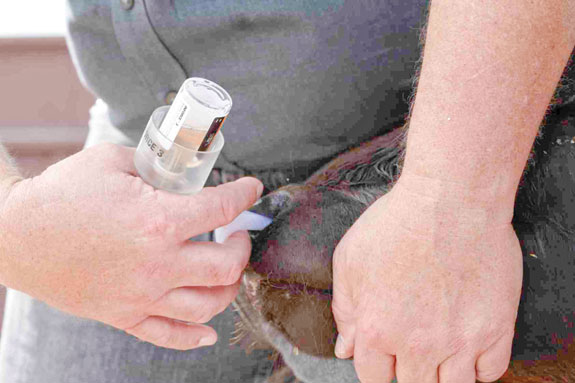Prevention is always superior to treatment, especially in the case of bovine respiratory disease (BRD). One of the most economically devastating diseases, BRD is estimated to cost the beef industry nearly $1 billion in economic losses in 2009 alone.
With the health and well-being of cattle – as well as producers’ profits – at stake, it’s important to consider the available vaccine technology, including new options such as an intranasal vaccine.
There are several considerations veterinarians and producers should take into account when selecting a BRD vaccine: pathogens that cattle are likely to encounter, speed of protection, impact of maternal antibody interference, strength of label claims, types or classes of cattle that will be vaccinated and veterinary advice.
Pathogens
No matter the operation, most BRD prevention strategies will likely include vaccination against the primary viral pathogens that are part of the BRD complex, such as:• Infectious bovine rhinotracheitis (IBR) virus
- Bovine respiratory syncytial virus (BRSV)
- Parainfluenza type 3 (PI3) virus
- Bovine viral diarrhea (BVD) Types 1 and 2 viruses
While each of these BRD-causing pathogens can be dangerous, BRSV is a primary cause of viral pneumonia and can be especially damaging to young calves from birth through weaning.
BRSV can play a major part in the BRD complex because of its frequency of occurrence, tendency to settle in the lower respiratory tract and ability to predispose the respiratory tract to secondary bacterial infections.
To minimize potential losses and help protect cattle in all stages of the production chain, many producers turn to traditional systemic, or injectable, vaccines.
While these vaccines can be important tools, producers also have the option of using an intranasal vaccine to help protect against three viral pathogens, including BRSV, IBR and PI3.
Speed of protection
In high-risk cattle, building immunity against the BRD viral pathogens should happen quickly to help avoid illness and profit losses.
Just like injectable vaccines, intranasal vaccines can help protect cattle against diseases that lead to BRD. However, intranasal vaccines also offer features not available in some systemic vaccinations.
By creating an immune response where viruses attack first, intranasal vaccines help to stimulate mucosal immunity and trigger a rapid innate immune response.
In fact, when studying early intranasal vaccines, researchers were able to show that intranasal vaccines helped demonstrate protection against IBR within 48 hours.
A quick onset of immunity can help get cattle started off on the right foot, whether dealing with calves at branding, high-risk stocker cattle or even feeder cattle.

Maternal antibodies
Ingestion of adequate quantities of colostrum in the first few hours after birth is critical to help ensure that a calf stays healthy during the first few weeks and months of life.
While the antibodies present in colostrum can help fight off diseases in a young calf’s system, they also can block the immune response following vaccination with some vaccines.
If the maternal antibodies block the immune response in calves, it may mean the given vaccine will not work as effectively as possible.
However, intranasal vaccines have been shown to help override blockage by maternal antibodies – an attribute especially important when calves are vaccinated at branding time.
Label claims
A vaccine’s label can provide a wealth of information to producers.
In addition to finding handling and administration indications, types and classes of cattle for which the product is intended and any safety precautions, producers also can find the label claims granted to a licensed vaccine by the Center for Veterinary Biologicals (CVB), which is part of the Animal and Plant Inspection Service in the U.S. Department of Agriculture (USDA).
Label claims are meant to give consumers an idea of the level of protection they can expect when they use the vaccine.
The decision as to which type of label claim will be granted is based on the CVB’s evaluation of the supportive efficacy data supplied by the vaccine manufacturer.
Type and class of cattle
At the cow-calf level, intranasal vaccines work well as an initial vaccine to help prime the immune system for a memory response to subsequent disease challenges.
Producers can then follow up with an injectable vaccine to generate a systemic memory response. Systemic vaccines have been demonstrated to help provide a duration of immunity – at least nine months for IBR and BVD for some injectable vaccines – helping provide additional respiratory protection against the viral components that are part of the BRD complex.
In stocker operations or feedlots, producers may not know the vaccination history of the calves they’re buying. But they still can help minimize the impact of viral diseases among groups of cattle.
Vaccinations on arrival with an intranasal vaccination utilize the advantages of stimulation of the local immune system and mucosal immunity.
“The biggest challenge in a stocker operation is finding the best and cheapest cattle – and that means you’re opening up the possibility of getting high-risk cattle,” says Danny Ownbey of Ownbey Feeders in Crowell, Texas.
“You have to have a game plan because you don’t know where these calves are coming from or how they’ve been handled, and you have to assume the worst.
Being aware of everything out there can help get some wheels under cattle and get a good strong foundation started for them.”
Ownbey, who manages cow-calf, stocker and feeder operations, says introducing an intranasal vaccine to his program was the best way to get the protection his high-risk stocker cattle needed.
“When I started buying some of these high-risk calves, I was pulling 30 to 40 percent the second time,” Ownbey says. “After beginning an intranasal, my repulls dropped to 10 percent.
Sometimes, when you have a program going, you’re apprehensive about changing it. But with an intranasal vaccine, it could be a change for the better. I saw quickly on our repull sheets that it was working immediately and that’s just another ‘what if’ that I could take out of the equation.”
Veterinary advice
When considering changes to a BRD vaccination program, it is extremely important for producers to talk with their veterinarian.
In fact, adding an intranasal vaccination to a herd health protocol is an excellent opportunity to review overall herd health and management – and no one is more knowledgeable about the unique needs of a producer’s herd than their herd veterinarian.
“Before I make any changes, I always visit with my veterinarian,” Ownbey says. “Whether it’s my cow-calf operation or the yearling operation, we always spend some time consulting.
I keep him informed on everything that’s going on and he visits from time to time because he wants to know what’s going on and wants to make sure that what he is being told is lining up with what he’s seeing.”
Given all of the advantages an intranasal vaccine can provide, cattleman should consider it as a tool to help ensure cattle are protected against potentially devastating diseases – both for the health and well-being of the cattle and for the producer’s bottom line. ![]()
PHOTOS
Intranasal vaccines help to stimulate mucosal immunity and trigger a rapid innate immune response.
Intranasal vaccines help prime the immune system for a memory response to subsequent disease challenges. Photos courtesy of Pfizer Animal Health.






